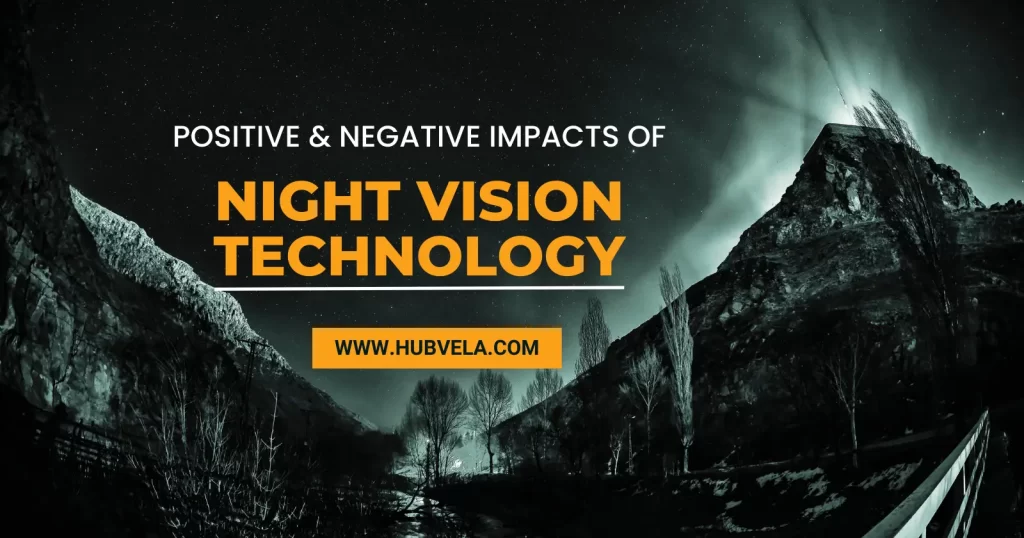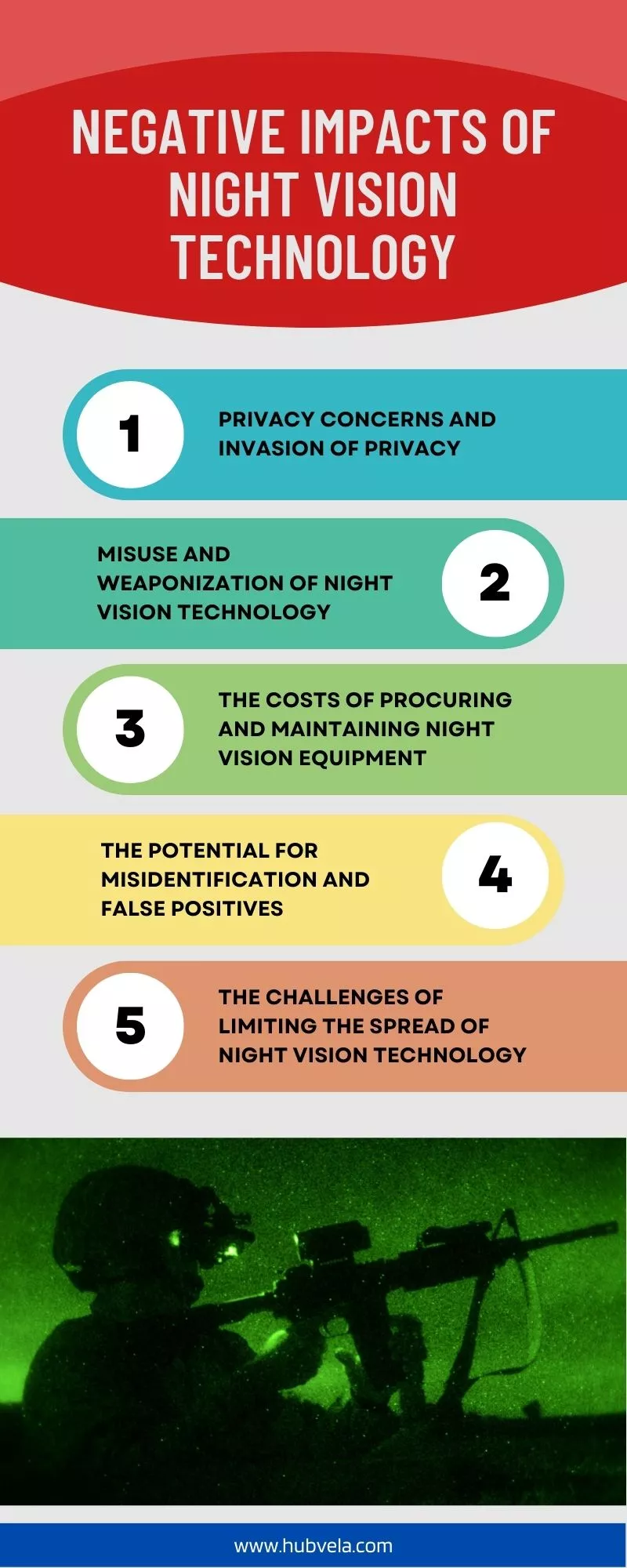Night vision technology has been around for decades and has been used in various fields, including military operations, law enforcement, and wildlife observation.
While it has undoubtedly provided many benefits, such as improved safety and security in low-light conditions, there are also negative impacts associated with its use.
In this article, we will explore both the positive and negative impacts of night vision technology.

--Advertisement--
Positive Impacts of Night Vision Technology
Night vision technology has come a long way since its inception, and it has had a significant impact on various fields.
The military has been one of the primary beneficiaries of night vision technology, with night vision systems being used in major operations such as Operation Desert Storm.
Night vision technology is also used in other areas such as law enforcement, wildlife observation, and even consumer electronics.
This technology works by amplifying ambient light or using thermal imaging to provide visibility in low-light conditions.
With advancements in this field, night vision technology has become more reliable and efficient, making it an essential tool for many applications.
Let’s discuss some of the major positive impacts of night vision technology.

1. Improved Safety and Security in Low-Light Conditions
With the help of night vision technology, people can see more clearly in the dark, which can be especially useful for driving at night.
Night vision works by collecting more light through the pupils and using rod cells to collect light for night vision.
In low-light situations such as shooting at night or in dark buildings, night vision technology can help maintain personnel safety and mission security.
Innovative lenses have also been developed to enhance sight at night and reduce the effects of night blindness.
Overall, night vision technology has improved safety and security in low-light conditions by providing better visibility.
2. Enhanced Military and Law Enforcement Operations
With the use of night vision technology, military and law enforcement personnel can operate in low-light conditions with greater efficiency and effectiveness.
This technology allows them to see in the dark, which is especially useful for surveillance, search and rescue operations, and tactical maneuvers.
Night vision technology has also been used to reduce the risk of friendly fire incidents during military operations.
The use of this technology has improved officer safety by allowing them to see potential threats before they become dangerous.
3. Increased Driver and Pilot Visibility
Hazards such as slickness, hydroplaning, compromised night vision, fog, and impaired drivers can affect anyone driving at night.
Night vision technology helps drivers and pilots see better in low-light conditions, making it easier to spot potential hazards on the road or in the air.
A study of driver perception of emergency warning lights found that blue and red lights have the greatest perceived saturation and were judged to be brighter than white and yellow lights of the same intensity.
Speed management is also key to road safety.
4. Enhanced Search and Rescue Operations
Enhanced search and rescue operations have been made possible with the use of night vision technology, which allows rescuers to see in the dark and locate individuals who may be difficult to find otherwise.
This technology has also helped to reduce the risks associated with search and rescue operations, as it enables rescuers to navigate through hazardous environments more safely.
In addition, night vision technology has been used in conjunction with GPS beacons to improve accuracy and efficiency during search and rescue missions.
Overall, the use of night vision technology in search and rescue operations has helped to save lives and improve outcomes for those in need.
5. Improved Monitoring of Infrastructure and Borders
Night vision technology can have a positive impact on infrastructure and border monitoring. Improved monitoring of infrastructure and borders can lead to increased safety, security, and efficiency.
For example, night vision technology can help detect potential threats or issues in real-time, allowing for quick responses to prevent damage or accidents.
This is particularly important for critical infrastructure such as ports, airports, and roads.
Additionally, improved border monitoring can facilitate the flow of goods and people across borders while maintaining security measures.
By enhancing visibility in low-light conditions, night vision technology can help improve the effectiveness of these efforts.
6. Enhanced Nighttime Navigation and Transportation
Night vision devices can greatly enhance night navigation, making it easier to recognize objects and people that would normally be unrecognizable to the unaided human eye.
This is especially important for military operations, search and rescue missions, and surveillance activities.
In addition, emerging technologies such as geofencing can help vehicles more safely react if the speed needs to be adjusted while driving at night.
With the use of night vision technology, drivers can have better visibility at night, reducing the risks associated with compromised night vision.
Overall, enhanced nighttime navigation and transportation through the use of night vision technology can improve safety and efficiency in various fields.
Negative Impacts of Night Vision Technology
Night vision technology has been a game-changer for military operations and other fields that require visibility in low-light conditions.
However, there are also negative impacts associated with this technology.
Infrared waves used in night vision goggles and other devices can negatively affect human health.
Additionally, the use of night vision devices can limit peripheral vision, which can be dangerous in certain situations.
We will explore some of the major negative impacts of night vision technology.

1. Privacy Concerns and Invasion of Privacy
Night vision technology can raise privacy concerns and lead to an invasion of privacy.
The use of night vision technology can allow individuals or organizations to see in the dark, which can include seeing into private spaces such as homes or businesses.
This can be a violation of privacy and lead to concerns about surveillance. As technology advances, it is important to consider the potential negative impacts on privacy and take steps to protect personal information.
Additionally, research has shown that privacy is important for psychological well-being and that a lack of control over personal information can cause stress and anxiety.
Therefore, it is crucial to balance the benefits of night vision technology with the need for privacy protection.
2. Misuse and Weaponization of Night Vision Technology
Night Vision Technology has been used by military forces to conduct covert operations and attacks at night.
Terrorist groups have also used night vision technology to carry out attacks under the cover of darkness.
Additionally, night vision technology has been used by poachers to hunt animals illegally at night. The misuse of this technology can lead to serious consequences for both humans and wildlife.
Furthermore, the weaponization of night vision technology can pose a threat to national security if it falls into the wrong hands.
It is important to regulate the use of this technology and prevent its misuse in order to minimize its negative impacts.
3. The Costs of Procuring and Maintaining Night Vision Equipment
The cost of night vision devices is high, with prices ranging from a few hundred to thousands of dollars.
Additionally, maintenance costs can be significant due to the complexity of the technology and the need for specialized training to operate and maintain it.
The night vision devices market was valued at USD 7679.14 million in 2021, and it is projected to be worth USD 12,199.31 million by 2027.
Despite these costs, night vision technology is used by military personnel, law enforcement officers, and first responders for nighttime surveillance, search and rescue operations, and covert operations.
4. The Potential for Misidentification and False Positives
Night vision technology has the potential for misidentification and false positives. False positives are a common issue in various fields, including threat intelligence, security operations, and incident response.
Similarly, eyewitness misidentification is a significant cause of injustice in the criminal justice system. False positives can create negative experiences for customers and lead to administrative friction.
Tests do not have perfect sensitivity or specificity, which means that false positive results (incorrectly identifying objects or people) and false negative results (missing instances of objects or people) are unavoidable in practice.
Therefore, it is essential to consider the potential for misidentification and false positives when using night vision technology to avoid negative impacts.
5. The Challenges of Limiting the Spread of Night Vision Technology
Night vision technology can be used for illegal activities such as poaching, smuggling, and burglary. It can also be used by terrorists or other criminals to carry out attacks under the cover of darkness.
Limiting the spread of night vision technology is challenging because it is widely available in the market and can be purchased online.
The military also uses night vision technology, which can make it difficult to regulate its use.
Additionally, advancements in computer vision and deep learning have made it easier to overcome low-level vision problems caused by rain and nighttime.
Therefore, there is a need for stricter regulations on the sale and use of night vision technology to prevent its misuse
Conclusion on the Positive and Negative Impacts of Night Vision Technology
In conclusion, night vision technology has both positive and negative impacts. On the positive side, it can be used for surveillance, search and rescue operations, and covert missions.
It can also help individuals see in low light conditions by amplifying ambient light.
However, there are also negative impacts such as the potential for eye strain or damage to the eyes if used improperly.
Additionally, some studies have shown that night vision technology may be less sensitive than other methods of detecting changes in transcriptional activation.
Overall, while night vision technology has many useful applications, it is important to use it responsibly and with caution.


